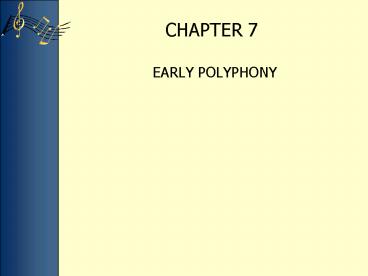EARLY POLYPHONY - PowerPoint PPT Presentation
1 / 12
Title:
EARLY POLYPHONY
Description:
ORGANUM IN MUSIC THEORY SOURCES. Western art music is marked by one important characteristic: polyphony not ... style called sustained-tone organum the bottom ... – PowerPoint PPT presentation
Number of Views:142
Avg rating:3.0/5.0
Title: EARLY POLYPHONY
1
CHAPTER 7
- EARLY POLYPHONY
2
ORGANUM IN MUSIC THEORY SOURCES
- Western art music is marked by one important
characteristic polyphonynot melody, not rhythm
but polyphony (the simultaneous sounding of two
or more independent musical lines).
3
Musica enchiriadis (Music Handbook c890s)
- Ascribed to Abbot Hoger (d. 906)
- First surviving written description of early
polyphony, or organum (pl. organa). - Intended to teach church singers how to improvise
polyphonic music on the spotto take a given
Gregorian chant and make it sound more splendid
by adding one or more lines around it.
4
Organum
- A term used to connote all early polyphony
generally. - Most organum in the Musica enchiriadis is
parallel organum (organum in which all voices
move in lockstep, up or down - Parallel organum at the fifth and then with
voices doubled at an octave. The existing
Gregorian chant is to be found in vox principalis
(principal voice).
- Micrologus (Little Essay c1030) written by Guido
of Arezzo (d. c1033) allows for contrary motion
in organum and discuss the occursusthe coming
together of voices at cadences.
5
An example of two-voice organum from Guidos
Micrologus showing a clear occursus at the end
- De Musica (On Music c1100) by John of St. Gall
situates the vox principalis (chant) as the lower
voice and the vox organalis (newly added voice)
above. The chant was now, and would remain, in
the lowest voice.
6
ORGANUM IN PRACTICAL SOURCES
- Winchester Troper (c1000) a book of tropes
written in Winchester, England, that also
includes the organal voice for about 150
two-voice organaKyries and Alleluias for the
Mass, for example. The exact pitches of the
polyphony cannot be determined with certainty.
7
Aquitanian polyphony
- A collection of some sixty-five pieces of
two-voice organum originating in monasteries in
the southern French province of Aquitaine. The
notation of these manuscripts gives precise
indication with regard to pitch. Acquitanian
polyphony often involves a style called
sustained-tone organumthe bottom voice holds a
note while the fast-moving upper voice
embellishes it in florid fashion. The end of the
opening phrase of the anonymous two-voice organum
Viderunt omnes exhibits such a moment of
sustained-tone organum.
8
Viderunt omnes
- An anonymous example of two-voice
- Aquitanian polyphony Viderunt omnes
9
The anonymous Viderunt omnes as it exists in the
original twelfth-century manuscript coming from
southern France
10
Codex Calixtunus
- (c1150 named after Pope Calixtus II) A
liturgical book and travel guide that includes
twenty polyphony pieces for the liturgy of St.
James the Apostle. The church of St. James
(Santiago) in Compostela, Spain, was a pilgrimage
site in the West second in importance only to
Rome.
11
An opening in the Codex Calixtinus
- Showing the three-voice organum Congaudeant
catholici by Master Albertus of Paris. - The Codex Calixtinus is the first manuscript to
ascribe composers names to particular pieces.
12
Congaudeant catholoci
- A transcription of Master Albertus Congaudeant
catholoci, the first example of three-voice music
to survive in a practical source.































